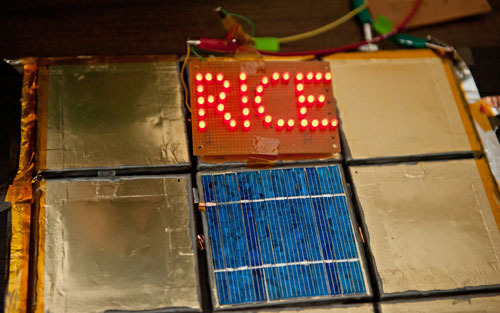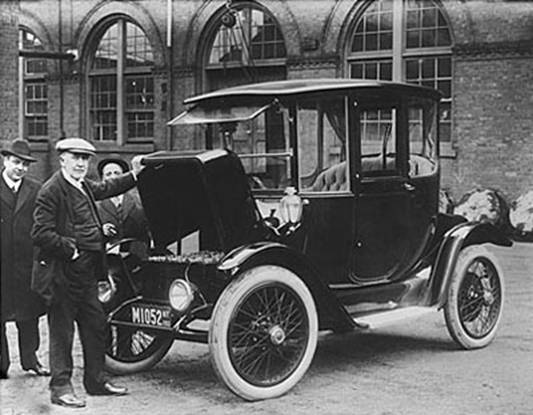Harry T. Roman's Blog, page 25
February 6, 2013
Happy Birthday Thomas Edison! (February 11th)

Born: Milan, Ohio
Occupation: Inventor, entrepreneur, project manager, technology leader, manufacturer, businessman
Accomplishments: 1,093 patents
Major industries impacted:
music industry (phonographs)
motion pictures (camera to projector)
power industry/electric light bulb
the West Orange invention factory [R&D labs]
Championed and built [100 years ago]:
electric vehicles
storage batteries
in-garage charging stations
revamped the concrete industry with new and larger kiln designs (Portland Cement)
major improvements to telephone in collaboration with Alexander Graham Bell
Most Recognized Edison Quote: “I have not failed 10,000 times. I’ve just found 10,000 ways that won’t work.”
Impact on the World:
The technology, inventions and industries that he created still account for $1.5 trillion of U.S. economy [about 10% of U.S. GDP]; about 4 times that for world economy
Life Magazine [1996] proclaimed him the “Man of the Millennium”
TIME Magazine featured him on cover of special July 2010 history issue-proclaiming him so relevant to our world today
Voice of America claims Edison’s technology is responsible for one-fourth of all the world’s jobs
He is the human icon for invention and creativity
Inspiration to generations of inventors and entrepreneurs
His multi-dimensional, multi-disciplinary method of problem solving has become the taproot for the hands-on, problem solving paradigm known as STEM, now sweeping the nation’s schools
FANS – Acknowledged Edison during their career
Steve Jobs, Apple
Jeff Bezos, Amazon
Google Team, Innovators
Bon Jovi, Musician
Tony Hsieh, Zappos CEO
FURTHER INFORMATION ON THOMAS ALVA EDISON
WWW.THOMASEDISON.ORG
WWW.EDISONMUCKERS.ORG
January 23, 2013
Breaking News!
Now there’s more information available on Thomas Edison; and the Edison Innovation Foundation.
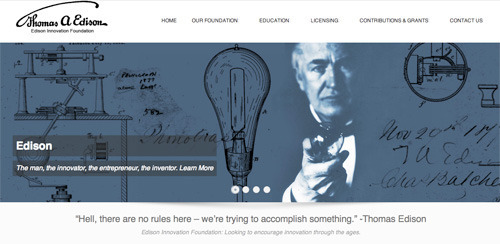
Check it out at www.thomasedison.org
You can “like” our new and improved site on Facebook, and check out the feeds on Twitter or Pinterest.
Learn how the Foundation licenses its trademarks, works with teachers and students, and spreads the Edison legacy.
January 1, 2013
Feel the Power, with Power Felt!
Thermoelectric power conversion, the conversion of temperature differences into electricity, is not new, but has been receiving increasing attention. New materials and technologies are propelling this technology forward. Now researchers at Wake Forest University have developed something very practical. They call it Power Felt, a kind of nano material, that can use body heat to generate useful amounts of electricity—the ability to charge a cell phone; and with further refinements, you could see them in toys as well.
Power Felt is composed of tiny carbon nano tubes locked within flexible plastic fibers, made to look like fabric. It creates a charge by using temperature differences, such as room temperature versus body temperature. Actually, anyplace there are small temperature differences, Power Felt fabric will harness them and generate minute amounts of electricity. Think about car seats, the inside lining of jackets, coats, clothing….etc. Can you see applications for the military?
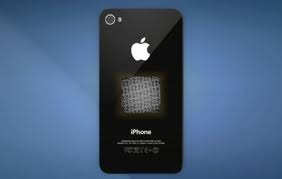
Power Felt in an iPhone
Here comes a big bonus. What’s that you say, no temperature difference….not to worry. Power Felt also has the ability to collect power from mechanical noise, any vibration that’s around it – the motion of the body or the vibration of a car, bus, truck, railroad car can be turned into small amounts of electricity. Think of the interesting possibilities. What about remote sensors powered by this fabric and then having power to transmit data…the ability to monitor critical infrastructure like bridges, buildings, equipment– a limitless ability for on-line, real-time monitoring. What about motion detectors and homeland security applications?
Such technology can change lots of things; and boy would Thomas Edison have loved this!
Editor’s Deep Dive:
http://www.newsobserver.com/2012/08/26/2293473/wake-forests-power-felt-a-hot.html
http://newrisingmedia.com/all/2012/8/30/you-could-soon-charge-your-gadgets-through-touch-alone-with.html
http://www.tomshardware.com/news/science-research-power-Felt-heat,14789.html
http://www.popsci.com/technology/article/2012-02/power-felt-lets-you-sit-your-phone-power-it
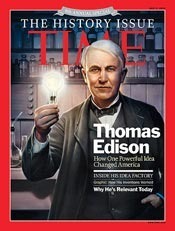 Thomas Edison said … “I never perfected an invention that I did not think about in terms of the service it might give others… I find out what the world needs, then I proceed to invent…. “
Thomas Edison said … “I never perfected an invention that I did not think about in terms of the service it might give others… I find out what the world needs, then I proceed to invent…. “Time ® is a registered trademark of Time Inc.
December 10, 2012
Celebrating Thomas Edison’s 130 Year-old Invention
![Drawing of Pearl Street Station [source-Wikipedia]](https://i.gr-assets.com/images/S/compressed.photo.goodreads.com/hostedimages/1381710317i/5213380.jpg)
Drawing of Pearl Street Station [source-Wikipedia]
In early September 1882, Thomas Edison culminated three year’s worth of inventive work to demonstrate his Pearl Street electric generating station in lower Manhattan [near the East River]. Originally having one generator and serving 40 electric lamps at 85 customer sites, the station grew by 1884 to have multiple generators serving 10,164 lamps at 508 customer sites. The electric utility industry was born 130 years ago.
Edison and his team designed a new rugged dynamo, the largest ever built, for use at Pearl Street. Nicknamed the “Jumbo”, each of the six units installed weighed 27 tons; and came equipped with a ten foot armature shaft, and capable of producing 100 kilowatts. Each dynamo was driven by a steam engine, which received steam from boilers located in another part of the plant. The Pearl Street plant was designed as a 600 kilowatt station and served an area of about one square mile. Today’s typical large utility generators turn-out 500-1,000 MW of power [1 MW = 1,000,000 watts]. It’s a very different and highly energy intensive world. In the typical New Jersey home in 1940, a home would have used about 700 kWh of energy for the whole year. Today, that same home consumes over 7500 kWh, a factor of ten more in total annual electric energy use.
![Drawing of Pearl Street Station [source-Wikipedia]](https://i.gr-assets.com/images/S/compressed.photo.goodreads.com/hostedimages/1381710317i/5213381.jpg)
Drawing of Pearl Street Station [source-Wikipedia]
What often is lost in discussions of the early utility system is the need for Edison and his staff to literally design, create, engineer, and implement every major component of that system-an inventive fugue that resulted in somewhere between 300 and 400 patents; including….generators, wires, switches, light sockets, meters, fuses, lamps, junction boxes….etc. Pearl Street station used a classic two wire distribution system. Edison also had to open a school to train his workers how to make the necessary cable installations under the busy New York City streets, and to make reliable connections from the cables to each customer. His fuel choice to power his steam boilers was coal. At his legendary West Orange, NJ Labs, built in 1887, Edison would install upgraded equipment to that at Pearl Street, powering the labs and also his home, located a scant half-mile away.
Underground distribution cable cross-section [source-IEEE]
![Edison workers busy installing the first utility grid in the streets of New York [source- http://theboweryboys.blogspot.com/2011/12/electric-new-york-from-gaslight-to.html]](https://i.gr-assets.com/images/S/compressed.photo.goodreads.com/hostedimages/1381710317i/5213383._SY540_.jpg)
Edison workers busy installing the first utility grid in the streets of New York [source- http://theboweryboys.blogspot.com/201...]
Today the U.S. electric utility industry is approaching $400 billion in annual revenue. Worldwide, utility revenues are about four times as large. National total utility power station capacity today is in excess of 1.1 million MW; using a variety of fuel forms—coal, natural gas, oil, hydro, nuclear and now solar and wind energy sources. Edison certainly would welcome the use of solar and wind resources, having been a big fan of the then emerging renewable technologies in the 1920s.……”I’d put my money on the sun and solar energy. What a source of power! I hope we don’t have to wait until oil and coal run out before we tackle that.”
Upon his death in 1931, well-meaning officials discussed shutting off the electric power to honor Edison’s achievements. They soon realized how dangerous that would be; and how absolutely necessary electric service was to our nation and safety. From 1882 to 1931, just 49 years, electricity made incredible market penetration in our world and to this day, it is the mainstay of our standard of living. Edison, the man who brought light and convenient and cheap electricity into our lives.
 Thomas Edison said … “My desire is to do everything within my power to free people from drudgery and create the largest measure of happiness and prosperity.”
Thomas Edison said … “My desire is to do everything within my power to free people from drudgery and create the largest measure of happiness and prosperity.”Time ® is a registered trademark of Time Inc.
November 19, 2012
Inventions Thomas Edison Would Love – Offshore Wind Machines
Mention wind machines and most folks think instantly of the large horizontal spinning propeller blade types that dominate the energy news; but wind turbines come in vertical axis types as well and there are some big benefits for using them. Sandia National Laboratories’ wind energy researchers are re-evaluating vertical axis wind turbines (VAWTs) to help solve some of the problems of generating energy from offshore breezes. The five-year, $4.1 million project began in January of 2012; and draws heavily on Sandia’s rich history with VAWT design and testing, going back to the 1970s and 80s.
VAWTs offer three big advantages that could reduce the cost of wind energy: a lower turbine center of gravity; reduced machine complexity; and better scalability to very large sizes. Having their drive-train more compact and lower to the water means a more stable machine and one easier and faster to maintain; and this design has fewer parts, not requiring a control system to orient toward the blowing wind. VAWTs are omni-directional. These characteristics fit the design constraints for offshore wind: the high cost of support structures; the need for simple, reliable designs; and economic scales that demand larger machines than current land-based designs.
Wind speeds are typically greater and more frequent offshore than on land, so locating them there makes good sense. According to experts at Sandia, large offshore VAWT blades in excess of 300 meters will cost more to produce than blades for onshore wind turbines. But as the machines and their foundations get bigger—closer to the 10–20 megawatt (MW) scale—turbines and rotors become a much smaller percentage of the overall system cost for offshore turbines, so other benefits of the VAWT architecture could more than offset the increased rotor cost.
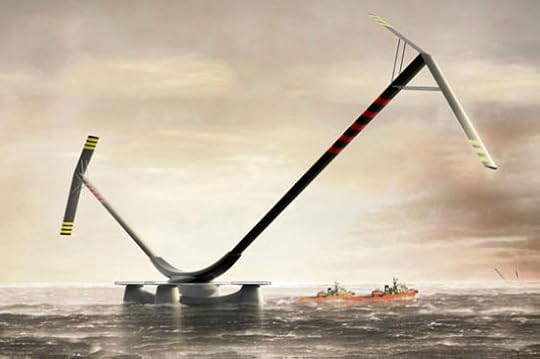
A futuristic offshore VAWT concept
Another engineering challenge will be the aerodynamic braking of the machines. Mechanical braking will need to be transitioned into a new design that allows the vertical rotors to brake more quickly, like the traditional horizontal axis wind machines do. This will keep Sandia engineers busy.
The first phase of the program will take place over two years and will involve creating several concept designs, running those designs through modern modeling software and narrowing those design options down to a single, most-workable design. In phase two researchers will build the chosen design over three years, eventually testing it against the extreme conditions that a turbine must endure in an offshore environment.
Editor’s Deep Dive
https://share.sandia.gov/news/resources/news_releases/vawts/
http://www.redorbit.com/news/science/1112666939/vertical-wind-turbine-offshore-power/
http://social.windenergyupdate.com/offshore-wind/vertical-axis-wind-turbines-only-way
http://en.wikipedia.org/wiki/Wind_turbine
 Thomas Edison said … “I always invented to obtain money to go on inventing.”
Thomas Edison said … “I always invented to obtain money to go on inventing.”Time® is a registered trademark of Time Inc.
October 29, 2012
Inventions Thomas Edison Would Love – Solar Photovoltaic Panels
Exciting solar news is coming out of MIT, the kind of inventive stuff that would make Thomas Edison proud.
How about two-part solar photovoltaic panels: the regular part we already know where the tiny solar cells within each panel captures the visible part of the incoming light; and then a new twist by MIT involving a film of carbon nanotubes? Much more of the sun’s energy could then be captured for the same size solar panel. The carbon-based cell is most effective at capturing sunlight in the near-infrared region-currently not attainable with traditional solar panels. Because the MIT nano material is transparent to visible light, such lightweight and thin films could be overlaid on conventional solar cells, creating a tandem device that could harness most of the energy of sunlight. Think of an optical sieve, where each of the two layers [nano tubes and conventional] would strain out that portion of sunlight to which it is attuned.
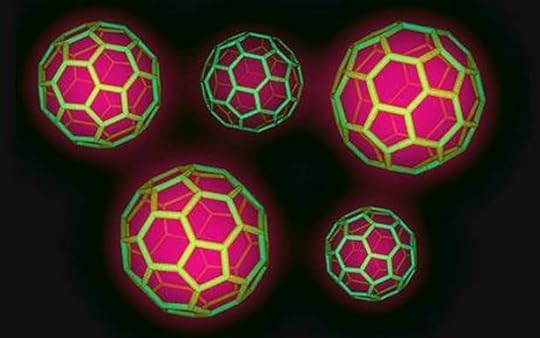
The new photovoltaic solar panel inner workings combines buckyball configurations (pictured) with carbon nano tubes.
More work needs to be done at MIT, but since 40% of the sun’s free energy lies in the near-infrared part of the sun’s spectrum, this is big news for the solar industry. This could double solar panel efficiencies; and radically increase the economics of solar photovoltaic systems.
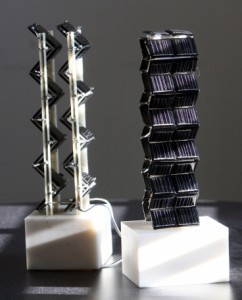 More news out of MIT … how about stacking solar cells in an accordion configuration—a 3D cell and panel system? It works, and its surface footprint is no larger than convention systems today, but you get much more energy out of the stacks within a solar panel—anywhere from 2-20 times as much. That is a big improvement and a real economic boost to the economics of solar.
More news out of MIT … how about stacking solar cells in an accordion configuration—a 3D cell and panel system? It works, and its surface footprint is no larger than convention systems today, but you get much more energy out of the stacks within a solar panel—anywhere from 2-20 times as much. That is a big improvement and a real economic boost to the economics of solar.
These 3D cell stacks produce lots of extra power whenever the sun is near the horizon, i.e. in the morning, evening, winter, or at latitudes far away from the equator. With conventional panels, it’s hard to capture low-angle light, but with an accordion cell structure inside each panel, this is not a problem. At MIT, researchers have optimized a 3D configuration of the cells within the panels.
Can you just see Thomas Edison, a 1920s advocate of solar and wind technologies, smiling at these two innovations! By the way, his son Theodore went to MIT, and he like his father was an inventor too; and also most likely smiling about this as well.
Editor’s Deep Dive
http://www.bloomberg.com/news/2012-06-21/carbon-buckyball-solar-panels-absorb-more-light-mit-says.html
http://www.rdmag.com/News/2012/06/Energy-All-Carbon-Solar-Cell-Harnesses-Infrared-Light/?et_cid=2708510&et_rid=54729976&linkid=http%3a%2f%2fwww.rdmag.com%2fNews%2f2012%2f06%2fEnergy-All-Carbon-Solar-Cell-Harnesses-Infrared-Light%2f
http://www.dailytech.com/article.aspx?newsid=24999
http://web.mit.edu/newsoffice/2012/three-dimensional-solar-energy-0327.html
http://www.extremetech.com/extreme/123719-mit-stacks-solar-panels-like-pancakes-increases-their-power-output-by-up-to-20x
 Thomas Edison said … “If we all did the things we are really capable of doing, we would literally astound ourselves….”
Thomas Edison said … “If we all did the things we are really capable of doing, we would literally astound ourselves….”Time ® is a registered trademark of Time Inc.
October 9, 2012
Thomas Edison – Project Manager Extraordinaire
In pioneering his invention factory concept, transforming invention from a cottage industry into a commercial powerhouse for new product development, Thomas Edison crafts the important corporate position we know today as project management. This key position in most companies belongs to men and women who know how to transform raw ideas into new products, using powerful team-based activities and coordination.
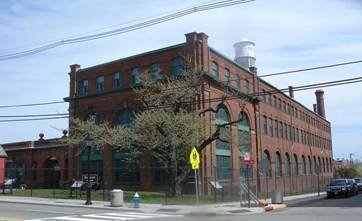
The Edison Invention Factory-Thomas Edison National Historical Park
Many project managers handle several projects at once, probably in related technologies, so as to maximize potential synergy between them. It was not unusual for Edison to have 30 or more projects proceeding simultaneously, cross-pollinating his ideas, and observations. To accomplish this, Edison used a variety of techniques as discussed below.
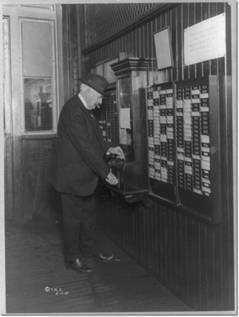
Thomas Edison clocking in another 90 week!
Tom worked as hard or harder than his teams, often putting in 90 hours a week of work. No one could accuse “the old man” of goofing off.
Laughter and practical jokes were an encouraged means by which his teams broke through roadblocks or let off steam creatively. [Tom gave as good as he got in the practical joke department!]
Creative tension was inherent in all work as Edison urged his teams to invent something minor every 10 days and something major every 6 months.
New technological and scientific advances were quickly exploited in the labs as his teams tried to create something useful from these breakthroughs. A key resource was the massive company library-where Edison kept his business office. There, 20,000 volumes contained the great scientific and technological achievements of the day, the raw materials for further innovations.
His inventors always had access to new information and plenty of raw materials to support their work. Edison often boasted he could make anything from a woman’s watch to a locomotive in his shops. His large storeroom contained just about everything his inventors would need.
Thomas understood the inevitability and possible serendipity associated with failure; and constantly encouraged his teams to learn from it. His famous line was “fail your way to success!”
To keep projects on track and new products on schedule, the great inventor used timelines, critical path analysis techniques, and exploded parts diagrams to show how assembly should be done in his factories. This was completely consistent with the rise of industrial efficiency models of the early 1900s.
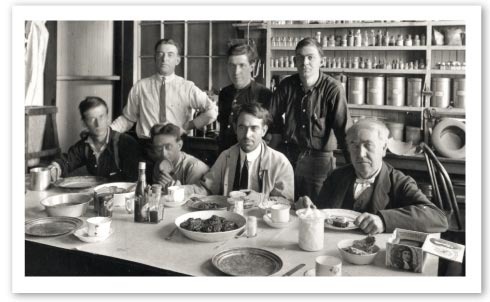
Tom and his “insomniac squad” having a meal after an all-nighter.
This all worked quite nicely, as the 250 employees who manned his invention factory, including team leaders, technical experts in physics/chemistry/engineering, and craftsmen produced enough new products to keep over 10,000 employees busy producing and shipping his products all over the world. All this productive activity occurred on about 20 acres of real estate. It was this tremendous leverage he achieved between R&D, new product development, and economic stimulus that propelled many of the nation’s then nascent corporations to develop project management directed R&D organizations-most of which were established between 1895 and about 1920. Edison had set the pace and path for economic progress, a paradigm we and the world still follow faithfully today.
 “Personally, I enjoy working about 18 hours a day. Besides the short catnaps I take each day, I average about four to five hours of sleep per night.”
“Personally, I enjoy working about 18 hours a day. Besides the short catnaps I take each day, I average about four to five hours of sleep per night.”Time ® is a registered trademark of Time Inc.
September 24, 2012
Instagram Star Founder – in the Mold of Thomas Edison
In the Internet market, entrepreneurship is alive and well, and increasingly populated with bright, young innovators. This 20-30 year-old crowd, is focused, and edgy about reaching out to new markets. They shape the market while serving it, which seems to be one of their hallmarks … living and thriving with constant change.

Consider Kevin Systrom, a computer “geek” as early as 12, this lanky fellow, soon realized his talents were in shaping ideas and markets, rather than the intricacies of computer science. He took management science and engineering in college; after all, if you are going to build a company … people, finances, and fund-raising powers the inventive pump of high-tech. Folks like Systrom learn through playful hands-on prototyping, and working with others through various early jobs [for him Google, G-Mail and the forerunner of Twitter] Quickly, young entrepreneurs like him become hungry for practical applications, making real products, ones that often tend to involve a bit of self-indulgence as well.
Systrom figured out how to take a personal passion for photography and make it into something others can enjoy. Hey, if do what you have fun with, you are not really working…are you? His Instagram site is about his love of pictures and social interactions. Instagram is not just about photos per se, but the ability to give those photos a personality as well, perhaps a retro, hip, nostalgic feel. You control the look and feel of the photo—the context through which they are viewed and perceived.
Here is what Wikipedia says about Instagram: “a free photo-sharing program and social network that was launched in October 2010. The service allows users to take a photo, apply a digital filter to it, and then share it with other Instagram users they are connected to on the social network as well as on a variety of social networking services. Instagram currently has 80 million registered users.” Kevin must be doing something right, as his company was sold in April 2012 to Facebook for approximately $1 billion in cash and stock, from which Systrom personally realized about $400 million.
Talking about photos … it is worth noting here that Edison teamed up with George Eastman of Eastman-KODAK fame, another entrepreneur, to make film strips for Edison’s first peep-hole motion picture shows-the original visual nickelodions. From this was launched the modern era of motion pictures.
So much of this Instagram success evokes Thomas Edison, a millionaire in his early 30s, a world-changing “wizard”; a fellow who originally worked as an itinerant telegrapher during the Civil War and applied his love of the technology and problem solving to mankind’s ultimate benefit. Like Systrom and other young entrepreneurs, Edison gave us huge change … recorded sound and motion pictures, the very basis of all smart phones; and the electric utility system to light our way and re-charge our smart phone batteries. Here are Edison’s four rules of business:
Think out of the box
Be entrepreneurial … take risks
Fail your way to success
Success demands that you improve your products
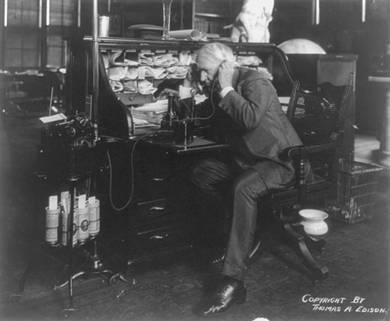
Betcha’ Kevin Systrom and his contemporaries have no trouble grasping what Edison meant 125 years ago!
Editor’s Deep Dive
http://en.wikipedia.org/wiki/Instagram
http://instagram.com/
http://www.forbes.com/sites/kashmirhill/2012/04/11/ten-reasons-why-facebook-bought-instagram/
http://www.forbes.com/sites/chunkamui/2012/08/07/how-long-before-facebook-writes-off-its-1b-purchase-of-instagram/
 “Anything that won’t sell, I don’t want to invent. Its sale is proof of utility, and utility is success.”
“Anything that won’t sell, I don’t want to invent. Its sale is proof of utility, and utility is success.”Time ® is a registered trademark of Time Inc.
September 10, 2012
Thomas Edison in Your Classroom … Attention Teachers!
Teachers … as you arrive back in school once more, bring Thomas Edison back with you and introduce his rich legacy to your students. Here are major points to develop lesson plans around; and show how Edison’s work is important to integrating the curriculum.
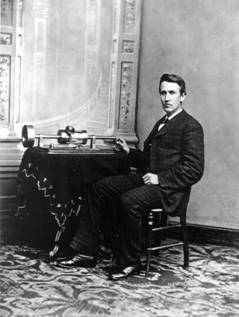 Edison has brought more wealth to civilization than any other human being. He died in 1931, but his accomplishments and industries created live on, representing 10% of the world’s economy. [LESSON PLAN HELPER: Connect history and technology and science]
Edison has brought more wealth to civilization than any other human being. He died in 1931, but his accomplishments and industries created live on, representing 10% of the world’s economy. [LESSON PLAN HELPER: Connect history and technology and science]
Undoubtedly, the educational discipline called STEM is being used in your school. Thomas Edison pioneered this interdisciplinary, multidimensional way of solving problems at his West Orange labs 125 years ago. [LESSON PLAN HELPER: Connect science, technology, engineering and math]
With Edison comes that indomitable spirit to never give up, in spite of failures. He epitomized the man who learned valuable lessons from failures…coining his famous quote….”Fail your way to success”. [LESSON PLAN HELPER: Connect science, technology, business and economics]
He created four huge industries…the electric light and utility industry, recorded sound, motion pictures and the modern day R&D lab. All together he had 1093 U.S patents; and counting his overseas patents the total climbs to 2332. His work is broad and deep in scope making him the greatest inventor who ever lived. Life Magazine proclaimed him the Man of the Millennia. [LESSON PLAN HELPER: Connect science, technology, engineering, math, history and economics]
With his creation of industrial R&D labs, Thomas Edison takes the industrial revolution of the late 1880s and extends it indefinitely into the future, systematizing the process of invention, completely changing the standards of living for all on planet Earth—giving us the concept of progress led by technological advancement…the heartbeat of today’s economies the world over. [LESSON PLAN HELPER: Connect creativity, innovation, invention and history]
Thomas Edison was an entrepreneur, a businessman who had both vision and the ability to see and shape new markets for his products. His famous four rules for business were:
Think out of the box
Be entrepreneurial … take risks
Fail your way to success
Success demands that you improve your products
[LESSON PLAN HELPER: Connect business, history, economics and innovation]
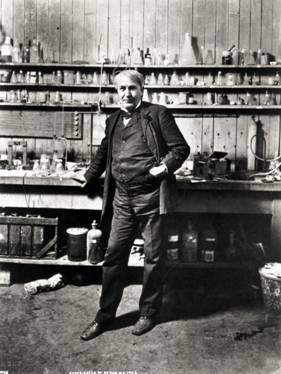 He saw great potential in both alternate energy technologies solar systems and wind energy; and pioneered the storage batteries needed for electric vehicles. He developed the concept for re-charging electric vehicles in a garage-his garage, all the way back in 1908. [LESSON PLAN HELPER: Connect science, technology, engineering and math]
He saw great potential in both alternate energy technologies solar systems and wind energy; and pioneered the storage batteries needed for electric vehicles. He developed the concept for re-charging electric vehicles in a garage-his garage, all the way back in 1908. [LESSON PLAN HELPER: Connect science, technology, engineering and math]
Thomas Edison was life-long learner and man of letters. He kept 4,000 laboratory notebooks and produced over 5 million written documents. This great man was a master communicator. [LESSON PLAN HELPER: Connect creativity, innovation, language arts and speaking skills]
There are numerous ways to bring Thomas Edison alive to your students in a way that complements your classroom and curriculum. Turn your kids onto this American icon, and they will reward you with a flood of invention and creativity!
Sources of Edison Information for your Classroom:
http://www.edisonmuckers.org/
http://www.thomasedison.org/
http://pinterest.com/thomasaedison/
http://www.nps.gov/edis/index.htm
https://twitter.com/#!/EdisonMuckers
https://www.facebook.com/OfficialThomasEdison
https://www.facebook.com/EdisonMuckers
https://twitter.com/#!/OfficialEdison
Classroom Activities to Try:
Have your students identify modern inventors, entrepreneurs, and creative individuals who have that Thomas Edison spirit [i.e. like Steve Jobs, Bill Gates and Dean Kamen] and discuss them in class.
Invite local inventors into your classroom to discuss how they solve problems and their inventions.
Challenge your class to do some inventing in class:
http://www.teachervision.fen.com/inventions/teacher-resources/6636.html
http://www.kidsinvent.com/
http://www.ehow.com/info_7874342_invention-activities-kids.html
Let us know how your kids react to Mr. Edison, or if you need some help … contact us at hroman@thomasedison.org.
Oh, by the way…2012 is the 135th anniversary of recorded sound-the phonograph [1877]; the 130th anniversary of the electric utility industry [1882]; and, the 125th anniversary of the West Orange Labs [1887]. Now there are some things to discuss in class!
 “I’d put my money on the sun and solar energy. What a source of power! I hope we don’t have to wait until oil and coal run out before we tackle that.”
“I’d put my money on the sun and solar energy. What a source of power! I hope we don’t have to wait until oil and coal run out before we tackle that.”Time ® is a registered trademark of Time Inc.
August 30, 2012
Inventions Thomas Edison Would Love: Storage Batteries
Sprayed-on Batteries:
Solar photovoltaic panels are not the only thing scientists and engineers are trying to paint on surfaces. Engineers at Rice University are reporting being able to spray paint batteries onto virtually any surface, making it possible to achieve all kinds of new designs and possibilities for incorporating battery storage into products and systems.
The battery [photo above] was sprayed onto a surface layer by layer in a process akin to 3D printing. Applied to bathroom tiles [gold surfaces in the photo] and hooked up to a solar panel, a set of the batteries provided a steady 2.4 volts, lighting up a set of LEDs that spelled out the word “Rice” for six hours.
After a few dozen charge / discharge cycles, the batteries retained most of their capacity. Much work remains to be done to improve battery performance; but since spray painting is a well-understood industrial technology, it should be easy to incorporate sprayed-on battery applications into existing and new manufacturing processes.
Revised Edison Nickel-Iron Batteries:
At Stanford University, scientists are taking Thomas Edison’s venerable old nickel-iron storage battery and turbo-boosting it, increasing its charging/discharging rate almost 1,000 times. All this means if you use these batteries for powering electric vehicles, you can fully charge the battery in about 2 minutes….not hours as required by conventional batteries. This technology could also make it possible to use such batteries as storage on the electrical grid.
The secret sauce here is nanotechnology, and while the new batteries are small and experimental, they should scale up nicely. Nickel, iron and carbon nanotubes, the main constituents of the battery along with a potassium hydroxide electrolyte makes this battery a potentially cheap system. It is envisioned to work in tandem with lithium-ion batteries now considered the ideal electric vehicle power source.
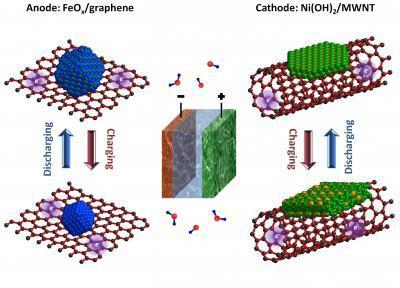
Stanford scientists have developed an ultrafast Edison battery by growing iron oxide crystals on graphene sheets and nickel hydroxide crystals on multi-walled carbon nanotubes.
Can you just see Thomas Edison smiling! Here he is below inspecting his nickel-iron storage batteries used to power his wife Mina’s 1914 electric vehicle. The car and batteries today are on display in his historic garage in West Orange, NJ; also the site of the first home garage charging station, all the way back in 1908. Now that was vision.
Editor’s Deep Dive
http://www.chron.com/news/article/Rice-researchers-tinkering-with-spray-on-battery-3673339.php
http://www.engadget.com/2012/06/29/rice-university-researchers-create-spray-on-battery-powered-bat/
http://esciencenews.com/articles/2012/06/26/stanford.scientists.spark.new.interest.century.old.edison.battery
http://www.latimes.com/news/science/sciencenow/la-sci-sn-edison-battery-20120626,0,6960650.story
 Thomas Edison said … “Surprises and reverses can serve as an incentive for great accomplishment. There are no rules here, we’re just trying to accomplish something”
Thomas Edison said … “Surprises and reverses can serve as an incentive for great accomplishment. There are no rules here, we’re just trying to accomplish something”Time ® is a registered trademark of Time Inc.
Harry T. Roman's Blog
- Harry T. Roman's profile
- 2 followers



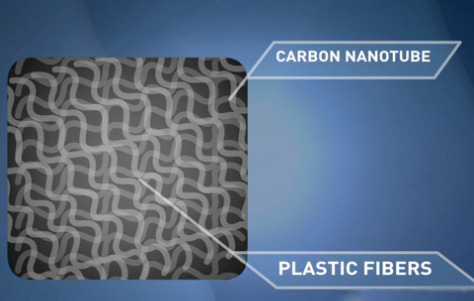
![Underground distribution cable cross-section [source-IEEE]](https://i.gr-assets.com/images/S/compressed.photo.goodreads.com/hostedimages/1381710317i/5213382.jpg)

